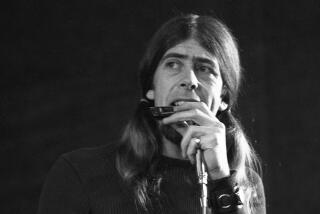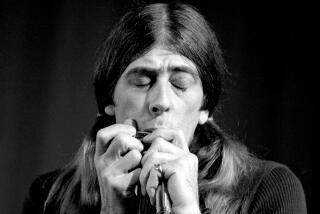Ray Brown: the Heart of Jazz
Ray Brown’s last appearance in the Southland took place a month and a half ago. Leading his trio in the opening set of one of his annual appearances at Catalina Bar & Grill, he again accomplished one of the feats of musical magic that characterized his long and productive career.
When the young members of his group seemed to have difficulty finding contact with the heart of the music, instead emphasizing harmonic coloration and fast-paced technical virtuosity, Brown took charge. Launching into a medley of Ellington-associated tunes, taking the lead on “Caravan,” carving out the groove on “Things Ain’t What They Used to Be,” he brought the music to life, transforming a well-crafted but bland performance into an evening of high-spirited, inventive jazz.
The transformation was subtle, primarily noticeable in the music’s inner essence, in the feeling of rhythmic lift and drive that he generated, rather than in any particular change in technical achievement. At the bottom line, it was the sort of shrewd metamorphosis, the capacity to trigger the spark of musical vitality, that was one of the fundamental elements in Brown’s creative genius.
What was especially remarkable about that capacity was that it flowed from the work of a bassist. Rooted at the heart of the rhythm section, delivering its energy at the lower end of the spectrum of sound, the instrument--and its players--traditionally played a supporting role in the early jazz years.
But its image began to change in the late ‘30s and early ‘40s through the performances of Jimmy Blanton with the Duke Ellington Orchestra.
“Before Jimmy,” bassist Arvell Shaw once said, “the bass just kept time. After Jimmy, the bass could lead the band.” He might have added that, for Brown, the bass did lead the band.
Brown died in Indianapolis on Tuesday. He was 75.
Arriving on the jazz scene a few short years after Blanton’s untimely death in 1942, Brown was well aware--as were his gifted contemporaries, Charles Mingus and Oscar Pettiford--of both the opportunity and the freedom that Blanton had established for his chosen instrument. He honed those qualities in his own playing while becoming one of the vital participants in the revolutionary arrival of bebop, a music that richly encouraged imagination, new ideas and emancipation from the musical establishment.
Moving easily from big bands to small ensembles, comfortably handling the very different musical demands of each, Brown was an established, innovative artist by the time he joined Oscar Peterson’s trio in the early ‘50s. And it was in this setting that he discovered the musical seeds that would eventually blossom into his own trios.
Like Art Blakey’s small bands, Brown’s trios became master-class seminars for musicians lucky enough to participate, especially a string of gifted pianists: Gene Harris, Benny Green, Geoff Keezer and Larry Fuller. And the great beauty of working with this legendary icon was the opportunity to fly freely, comfortably supported by Brown’s rhythmic wind beneath one’s musical wings.
On that late May evening at Catalina’s, Brown was so alive, hovering magisterially over his bass, urging his players forward, smilingly interacting with the enthusiastic crowd, that it’s almost impossible to believe that he is suddenly, stunningly, gone from the lives of those who loved and admired him, personally and professionally.
One can only assume that, given the choice, he may well have elected to go as he did, still at the peak of his musical powers, actively performing with his trio, taking a nap following an afternoon game of golf.
But none of that alters the fact that Brown will be missed mightily, that--with all he had already said musically--there was still much more that might have been said, that the music has lost yet another of its great, original voices.
More to Read
The biggest entertainment stories
Get our big stories about Hollywood, film, television, music, arts, culture and more right in your inbox as soon as they publish.
You may occasionally receive promotional content from the Los Angeles Times.










